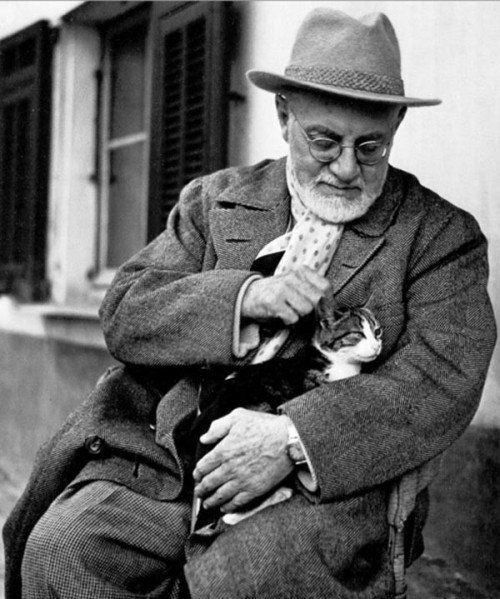
Henri Matisse (1869-1954) was a French painter, sculptor, and printmaker, known for his revolutionary contributions to the art world. His innovative use of color and form, coupled with his bold experimentation with new techniques and styles, have had a lasting impact on the development of modern art.
Early Life and Education:
Matisse was born in Le Cateau-Cambrésis, a small town in northern France. His father was a grain merchant, and his mother was an amateur artist. Matisse began painting as a hobby while studying law in Paris, but soon became disillusioned with the field and decided to pursue a career in art. He enrolled at the Académie Julian and then the École des Beaux-Arts, where he studied with the academic painter Gustave Moreau.
Matisse's early works were influenced by the Impressionist and Post-Impressionist movements, but he quickly developed his own distinctive style. In 1905, he exhibited his painting "Woman with a Hat" at the Salon d'Automne, which caused a scandal due to its vivid colors and loose brushstrokes. The work was criticized by some as being too radical, but it also caught the attention of other artists who would later become known as the Fauves, or "wild beasts."
Fauvism:
Fauvism was a short-lived but influential movement in French art that emerged in the early 1900s. Its members included Matisse, André Derain, Georges Braque, and Raoul Dufy, among others. Fauvist artists rejected traditional techniques and rules of representation, instead using bold, bright colors and simplified forms to express their emotional responses to the world around them.
Matisse's Fauvist works, such as "The Joy of Life" (1906) and "Blue Nude" (1907), are characterized by their expressive use of color and form. He used flat, bright colors to create a sense of depth and dimensionality, and experimented with compositional elements such as line and shape to convey movement and emotion.
Later Career:
In the years that followed, Matisse continued to experiment with new techniques and styles. He developed a keen interest in sculpture, creating works such as "The Back" (1909-1930) and "Large Reclining Nude" (1935). He also became interested in collage, a technique in which materials such as paper and fabric are glued onto a surface to create a work of art. Matisse's collages, such as "The Snail" (1953), are notable for their use of color and shape to create complex, abstract compositions.
Matisse's later works are characterized by their simplicity and clarity of form. In his later years, he suffered from poor health and was unable to paint on a large scale. Instead, he turned to creating paper cutouts, a technique in which he cut shapes out of painted paper and arranged them into compositions. His cutouts, such as "The Blue Nude II" (1952) and "The Sheaf" (1953), are admired for their use of color and form to create a sense of depth and movement.
Henri Matisse was a prolific artist who created many notable works over the course of his career. Some of his most famous and influential works include:
-
"Woman with a Hat" (1905) - Matisse's first Fauvist painting, which caused a scandal at the Salon d'Automne due to its vivid colors and loose brushstrokes.
-
"The Joy of Life" (1906) - a Fauvist masterpiece featuring a group of nude figures in a vibrant, lush landscape.
-
"Blue Nude" (1907) - another Fauvist work, notable for its expressive use of color and simplified, abstract forms.
-
"Dance" (1910) - a series of two large-scale paintings featuring dancers in a circle, which Matisse created for the Russian businessman Sergei Shchukin.
-
"The Red Studio" (1911) - a painting that features a studio filled with bright red furniture and objects, which Matisse described as a self-portrait of his own creative process.
-
"The Back" (1909-1930) - a series of sculptures depicting a woman's back, which Matisse worked on over the course of several decades.
-
"The Snail" (1953) - a collage made up of many small pieces of brightly colored paper, arranged in a spiral pattern.
-
"The Blue Nude II" (1952) - a paper cutout featuring a reclining female figure, notable for its use of color and simplified forms.
These works, along with many others, showcase Matisse's innovative use of color, form, and technique, and his willingness to push the boundaries of traditional art forms.
Legacy:
Henri Matisse's contributions to the art world have had a lasting impact on the development of modern art. His innovative use of color and form, coupled with his willingness to experiment with new techniques and styles, have inspired generations of artists. His works can be found in museums around the world, including the Museum of Modern Art in New York, the Musée National d'Art Moderne in Paris, and the Tate Modern in London.
In conclusion, Henri Matisse was a groundbreaking artist who revolutionized the art world with his use of bold, bright colors, simplified forms, and experimental techniques. His contributions to the Fauvist movement, as well as his later innovations in sculpture and collage, have had a lasting impact on modern art. Matisse's legacy as an artist is not only reflected in the many museums and collections around the world that showcase his work, but also in the continued inspiration he provides to artists today who seek to push the boundaries of traditional art forms.








